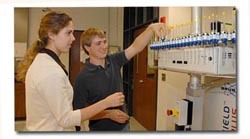The University of Notre Dame’s research awards have exceeded the $100-million mark for the first time in its history, fulfilling a goal set by Rev. John I. Jenkins, C.S.C., Notre Dame’s president, during his 2005 inaugural address.
“This is an important milestone for Notre Dame because it signals progress toward our goal as a pre-eminent Catholic research university,” Father Jenkins said. “It shows that our faculty are making valuable discoveries in areas as diverse as nanoscience technology and conflict resolution.”
The milestone was reached on April 6 with the arrival of a $93,158 grant from the National Science Foundation to Karsten Grove, professor of mathematics, for a study titled “Geometry and Topology in the Presence of Lower Curvature Bounds.”
The $100-million total reflects an increase in the number of grants proposed, an increase in the size of those proposals, and an increase in the number and size of grants that are winning funding, said Robert Bernhard, vice president for research.
“This milestone is due in all respects to the research vision and hard work of our faculty. Their enthusiasm to form teams across disciplines and institutions builds on our strong tradition of individual contributions. The enthusiastic support of our deans also has been vital,” Bernhard said.

Since 2007-08, when Bernhard began to lead the University’s research office, the number of proposals written and submitted has increased by 34 percent, and the size of proposal requests has doubled. By the end of March 2008, faculty had garnered $64 million in awards, compared to the $100-million milestone just reached.
The milestone is a tangible sign of the benefits Notre Dame has begun to realize by initiating a program to provide seed funding for research. Called Strategic Research Investments (SRI), the program has invested $80 million of the University’s own money to advance the scope, excellence and visibility of the research enterprise.
The funds have been used to hire new faculty, purchase cutting-edge research equipment and provide personnel support that frees more time for faculty to pursue research projects. As a result of this support, “Our faculty members can confidently compete against their peers,” Bernhard said.
While the current upswing in successful research reflects the early stages of the SRI investment, the full potential of the program has not yet had time to peak, he said. “When this investment is fully realized, I believe we will see the development of a transformative component of our research programs.”
Certain external factors have helped define 2009-10 as a bountiful year. Among those factors, federal economic stimulus money under the American Recovery and Reinvestment Act of 2009 has totaled nearly $30 million. Those funds have included awards such as $18.5 million to Peter C. Burns, Massman Chair and Professor of Civil Engineering and Geological Sciences, to establish an Energy Frontier Research Center. The focus is on the materials science of actinides, and the center intends to lay the scientific foundation for advanced nuclear energy systems that may provide much more energy while creating less nuclear waste.
Also noteworthy, a $12.2-million renewal grant from the National Institutes of Health to the VectorBase project to support the work of biologists Frank Collins and Nora J. Besansky, co-principal investigators, and Greg Madey and Scott Emrich of computer science and engineering.